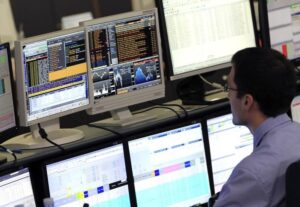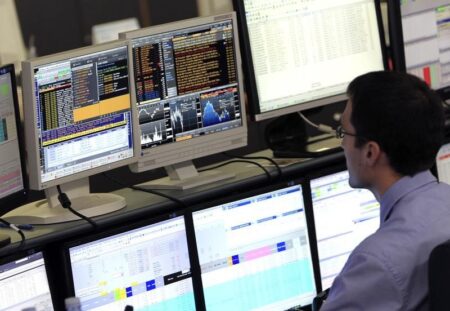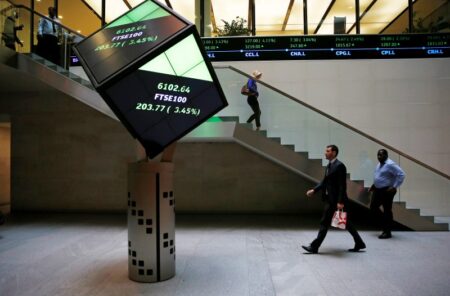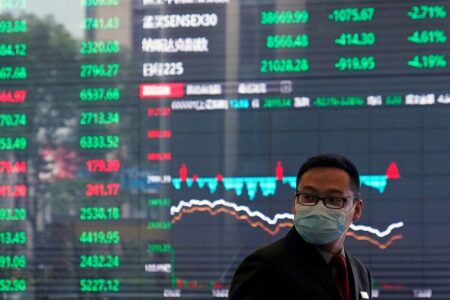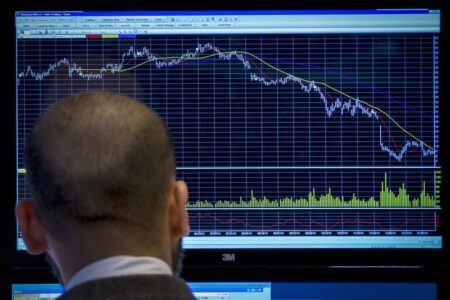By Harry Robertson
LONDON (Reuters) -European shares fell and U.S. stock futures slipped on Thursday after turbulent sessions in Asia and on Wall Street, as investors struggled to find their footing in a wild week for markets.
The yen and U.S. bonds rose as traders waited for U.S. weekly jobless claims data, which has taken on extra significance after weak employment numbers helped spark Monday’s market rout.
Europe’s continent-wide index fell 0.9% after climbing 1.5% on Wednesday. index was down 0.6% and 100 dropped 1%.
Futures for the U.S. were down 0.2%. The index fell 0.8% the previous day, having given up gains of as much as 1.7% in morning trading.
“When you have a volatility shock like this, and you have a degree of unwind in certain positions, you’re very prone to sudden reversals and also a degree of uneasiness as the adjustment continues,” said Erik Nelson, macro strategist at Wells Fargo.
“I would be surprised if we just went back to everything being fine.”
share index swung from early losses of as much as 2.5% to gains of 0.8% before finishing 0.7% lower.
Weak U.S. jobs data last week has combined with a dramatic rally in the Japanese yen and concerns about an artificial intelligence bubble to send stocks tumbling.
The S&P 500 slumped 3% on Monday and sits 2.8% lower for the week – although it still remains around 9% higher for the year.
YEN BOUNCES AROUND
Japan’s yen rebounded somewhat on Thursday, adding to investor unease, after dropping around 1.6% on Wednesday. The dollar was last down 0.3% at 146.26 yen.
The yen has surged 11% since hitting a 38-year low in July, helped by intervention from authorities, a surprise Bank of Japan rate hike, and the U.S. jobs slowdown that has weighed on the dollar.
The rally has forced investors to dramatically unwind carry trades, where they borrow cheaply in Japan to buy dollars and other currencies to invest in higher yielding assets, and helped trigger a 12% plunge in Japanese stocks on Monday.
Deputy BOJ Governor Shinichi Uchida on Wednesday played down the chance of another near-term hike, but minutes released on Thursday revealed a hawkish slant among the board.
The was little changed on Thursday at 103.12, after hitting an eight-month low of 102.69 on Monday. The euro and the pound were also flat.
The yield on the benchmark 10-year U.S. Treasury note was last down 6 basis points (bps) at 3.909%, after rising on Wednesday following a weak debt auction.
It is down 9 bps for the week after hitting its lowest since June 2023 on Monday as traders fled to safe-haven assets and ramped up their bets on Federal Reserve rate cuts. Yields move inversely to prices.
“The rates (government bonds) market to my mind has overshot even more than the equity market,” said Carl Hammer, global head of asset allocation at SEB.
Hammer said markets are expecting too many interest rate cuts from central banks. “When I look at most of the growth metrics that we follow, I am not overly concerned,” he said.
Traders on Thursday expected around 110 bps of interest rate cuts from the Fed this year. Weekly U.S. jobless claims data at 1230 GMT (8.30 a.m. ET) could shift those expectations.
Crude oil dipped slightly after rising the previous day when data showed a bigger-than-expected drawdown in stockpiles.
futures fell 0.3% to $78.06 a barrel. It hit an eight-month low of $75.05 a barrel on Monday.
Read the full article here




